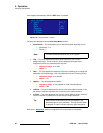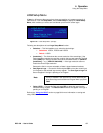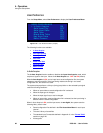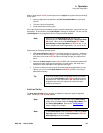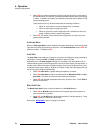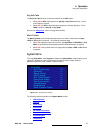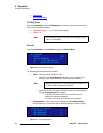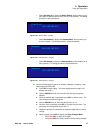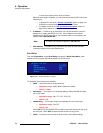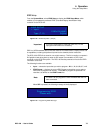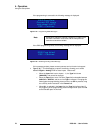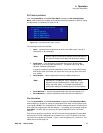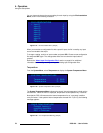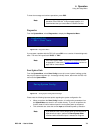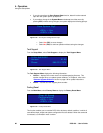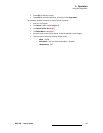
74 DCS-100 • User’s Guide
4. Operation
Using the Setup Menu
In each case, system returns to the root menu.
When Ethernet setup is complete, you can communicate with the DCS-100 via the
Ethernet port.
~ In Appendix B, refer to the “Remote Commands” section on page 132
for details on communicating with the DCS-100 via Telnet.
~ In Chapter 5, refer to the “GUI Connection and Launch” section on
page 102 for details on running the web-based GUI.
• IP Address — The IP line is an information-only line that shows the current IP
address in all modes (with DHCP on or off). If an IP address has not been
established (no DHCP server found, or the network cable is not connected), the
address reads "000.000.000.000."
• MAC Address — The M line is an information-only line that shows the MAC
(hardware) address of the unit's Ethernet port.
pÉêá~ä=pÉíìé
From the System Menu, select Serial Setup to display the Serial Setup Menu, which
enables you to set system RS-232 parameters for the serial port.
Figure 4-41. Serial Setup Menu (sample)
The following Serial functions are available:
• Baud — Use this function to set the baud rate.
~ Adjustment range: 9600, 38400, 57600 and 115200
~ Default: 115200
• Parameters — This function is a combined setting of Parity, Data Bits and Stop
bits (in this order).
~ Adjustment range: N81, E71, O71, E72, O72
~ Default: N81
• Handshaking — This function controls the hardware flow of the serial port.
~ Adjustment range: ON, OFF
~ Default: ON
When ON, RTS/CTS and DSR/DTR are used to control the data flow in and out of
the serial port. When OFF, the state of these control lines is ignored.
• Reset — Use this function to reset all serial values to their default settings.
Note
The DCS-100’s default IP address is 192.168.0.10
SERIAL SETUP
> Baud 115200
Parameters N81
Handshaking ON
Reset



